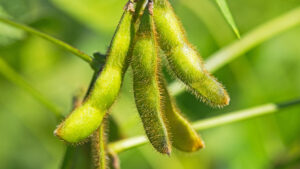As the reports of damage continue to file in, university and company experts try to identify the cause.
Intended to give farmers another tool in their toolbox to control weeds, the new formulations of dicamba that were supposed to be less volatile have led to thousands of acres of crop damage and hundreds of complaints filed with state departments of agriculture throughout the Midwest and South.
Arkansas was one of the first states to see the complaints file in. By June 23, state regulators had received 242 complaints from farmers saying their crops had been damaged. That number has since increased to more than 600 complaints.
“Nobody was quite prepared, despite extensive training, for just how sensitive beans were to dicamba,” says Bob Scott, a University of Arkansas Extension weed specialist.
In Missouri, the soybean association estimated that more than 200,000 acres of soybeans were damaged by dicamba this year.
As such, on July 7 both Arkansas and Missouri announced a ban on the sale and use of dicamba products for agriculture, each with slightly different terms.
Arkansas halted the sale of dicamba for agricultural use in that state for 120 days, effective July 11. Meanwhile, Missouri banned the sale and use of all dicamba products labeled for agricultural use in the state, which went into effect immediately.
“We want to protect farmers and their livelihoods,” said Chris Chinn, Missouri Director of Agriculture. “At the same time, my commitment to technology and innovation in agriculture is unwavering. That’s why I am asking the makers of these approved post-emergent products, researchers and farmers to work with us to determine how we can allow applications to resume this growing season, under certain agreed upon conditions.”
Monsanto, BASF and DuPont had each developed new formulations of dicamba; Monsanto created XtendiMax with VaporGrip technology, while BASF developed Engenia and DuPont FeXapan. At Chinn’s urging, they came together to set increased requirements for use of these products within the state.
A few days later (July 13), Director Chinn issued a notice of release for the sale and use of these products
“From the moment the stop sale and use order went into effect, we’ve been working to get these weed control products back into the hands of our farmers,” she said. “BASF, Monsanto and DuPont came to the table and agreed to additional safeguards for product use in response to issues we’ve faced this growing season.”
The additional special local needs identified include:
- Wind speed. The product is not to be applied when wind speeds are greater than 10 miles per hour. Applicators must measure and record wind speed and wind direction for each field prior to application.
- Application timing. The product is not to be applied before 9 a.m. and not after 3 p.m.
- Certified applicator. All applications must be made by a properly licensed Missouri certified private applicator or certified commercial applicator, certified noncommercial applicator or certified public operator.
- Dicamba notice of application form. Certified applicators must complete an online web-based form, known as the Dicamba Notice of Application, prior to the actual application.
- Recordkeeping requirements. Certified private applicators, certified noncommercial applicators and certified public operators must keep and maintain a record of use for each application of these products.
After also seeing increased dicamba drift complaints, Tennessee added measures, which extend through Oct. 1, to help mitigate the risk of herbicides containing dicamba.
At the time of print, Arkansas’ ban remained in place, and as a result of the damage, seven Arkansas farmers filed a lawsuit July 19 against Monsanto, BASF and DuPont Pioneer for the alleged crop damage that occurred as a result of the off-target movement of the new dicamba formulations.
If the new formulations were indeed designed to be less volatile and less likely to drift, what went wrong? That seems to be the million-dollar question.
Likely Causes
“The biggest problem is the sensitivity of non-Xtend soybeans to dicamba herbicide,” says Tom Barber of the University of Arkansas. “As we have seen in our research, a very low rate (1/30,000X) of dicamba can cause soybean leaves to cup.
“No, there will not be any yield loss at this low of a rate, but you will still see the injury on the beans.”
Barber says that while most growers and applicators took the training course on how to best use and apply these products, some still decided to spray with the wrong nozzles, during times of high winds, disregarding the buffer zones or at night during a temperature inversion.
“This physical drift accounts for at least 80 to 90 percent of all the dicamba injured fields that I have personally walked,” he says. “The other 10 to 20 percent is not that easy to figure out.”
Some growers and applicators had the correct setup, measured off the appropriate boarders and sprayed Engenia when the wind was blowing away from susceptible soybeans, in some cases with a broadcast hooded sprayer.
Barber says these are the fields that have him scratching his head, wondering how dicamba symptoms appeared a quarter-mile upwind.
The two conclusions that he can come up with: “Either there was a small amount of volatility that occurred, but enough to cause some symptomology or another theory might be that the dicamba droplets are moving on dust particles after the application is made.”
However, Larry Steckel, a University of Tennessee weed scientist, says the drifting dicamba might have more to do with the time of the year and temperature.
“Instead of spraying it in February, March and April [like we do for corn], we are now spraying it in June and July — hot times of the year,” he says.
Kevin Bradley, a University of Missouri weed scientist, and Iowa State’s Bob Hartzler agree with Streckel that timing is one big difference. “We haven’t been spraying dicamba in June and July on soybean,” Bradley says.
Hartzler says that another possible source of damage might result from dicamba use rates.
“The post emergence rate for dicamba is 0.5 pounds per acre in both corn and dicamba-resistant soybeans,” he says. “However, dicamba rates in corn are usually reduced significantly since it is often tank-mixed with other herbicides or because of crop injury concerns. Labels of products registered for use in dicamba-resistant soybeans do not allow reduced rates.”
Hartzler notes the use patterns of dicamba in soybeans increase injury risk compared with how it’s been used in corn.
Companies Respond
After spending the last few weeks of July traveling through Missouri, Tennessee, Arkansas, Iowa, Illinois and South Dakota to visit with soybean farmers, consultants and academics, Monsanto’s Chief Technology Officer Robb Fraley says he saw a mixed picture.
“On the one hand, I saw and heard a lot of success stories from growers and applicators in every state where our XtendiMax product has been approved for in-crop use,” he says. “In fact, I would say that most of the farmers I visited with are very pleased with their weed control this season, and I could see why.
“Their fields are showing very good control of difficult weeds, such as water hemp and pigweed, that they have been dealing with for years.”
But on the other hand, Fraley says he also saw fields exhibiting clear symptomology.
“I understand why these farmers are angry and concerned and are looking for answers,” he says. “The symptomology I saw — and what most farmers experiencing symptomology are seeing — was leaf cupping,” he explains. “While leaf cupping can be caused by dicamba, it can also be caused by many other things, including environmental factors, diseases and other crop protection products.
“For that reason, diagnosing the problem can be complex, especially when there have been relatively few inquiries in closely neighboring states. In fact, Arkansas, the only major cotton and soybean growing state where Monsanto does not sell XtendiMax, has received nearly twice as many inquiries as every other state combined.”
To read more about Fraley’s field observations, visit “Talking Dicamba with Farmers — What I Learned.” https://medium.com/@RobbFraley/talking-dicamba-with-farmers-what-i-learned-3830a07c6e75
Monsanto’s Brian Naber, U.S. commercial operations lead, says the company continues to investigate the cause of damage.
“We’re in the early stages, for sure,” Naber says. “But to this point, the indications are that volatility of the approved over-the-top product is not the major source of the off-target movement. Instead, the evidence we’re seeing is pointing to: Illegal applications of non-approved products; lack of compliance with the labeled spray requirements; and direct application of contaminated products that can result from either improper tank clean out or the use of contaminated products.”
In helping respond to the complaints, BASF has already deployed more than 400 field representatives to answer questions and concerns.
Scott Kay, BASF business director, says one of the key ingredients to getting a good experience when it comes to application is using the right nozzle.
“We’ve invested heavily and have distributed those nozzles to our customers,” he says, noting that more than 600,000 nozzles were purchased and given to customers.
While both companies continue to investigate the cause of damage, farmers and experts both agree that accessibility to new tools to help control weeds is important to their future success.
“Agriculture is in a difficult position in determining how best to move forward regarding the expanded use of dicamba and the risks posed by this technology,” says Iowa’s Hartzler. “There is not denying that new tools are needed to aid in weed management as problems with herbicide-resistant weeds continue to spread.”













